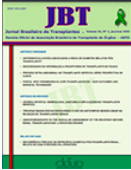Intra-Abdominal Pressure in Hepatic Transplantation: Prospective Case Series
DOI:
https://doi.org/10.53855/bjt.v24i1.5Keywords:
Intra-abdominal Hypertension, Liver Transplantation, Acute Kidney InjuryAbstract
Introduction: Intra-abdominal hypertension (IAH) is a common complication in critically ill patients, which can trigger organ dysfunction and mortality. Liver transplant can produce several risk factors related to IAH, and such phenomenon may subsidize important information on the development of acute kidney injury in the early postoperative period in this group of patients. Purpose: This article aims to quantify intra-abdominal pressure (IAP), describe IAH prevalence and assess the association of IAH and AKI in liver transplanted recipients. Methods: This is an observational and analytical study, prospectively carried out during the SARS-COV-2 pandemic. It was composed by a convenience sample that included patients submitted to orthotopic liver transplantation divided into groups H (IAP >12 mmHg) and N (IAP <12 mmHg). A re-categorization was performed to adapt the new sample size. Results: 16 liver transplants were performed during the period of the study, from which seven patients were included in these analyses. A total of 46 IAP measurements were carried out on the sample. There was no difference between groups H and N in Body Mass Index (BMI), Model for End-Stage Liver Disease Sodium (MELD-Na), ascites volume and reperfusion syndrome. The median IAP was 10.5 mmHg immediately after transplantation, which was reduced to 8.5 mmHg after 48 hours. The hemodynamic profile was quite similar between groups. However, there was a greater use of vasoactive drugs in group N and intravascular fluids in group H. Conclusion: There was no association between AKI in patients affected by IAH after liver transplantation. This result may not reflect the relationship between AKI and IAH in this population due to the size of the studied sample. It was not possible to establish significant differences between groups H and N, and the prevalence of IAH was restricted to moderate levels. The results of hemodynamic management suggest that better outcomes may be obtained by using vasoactive drugs instead of large volumes of intravascular fluids.









